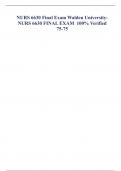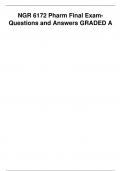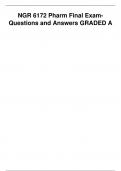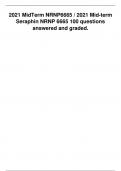ACE IT!
Welcome to your gateway to success! With access to an exclusive library of study materials that are more than just books – they're your ticket to acing those exams and reaching your educational goals. We've handpicked the most potent tools, from textbooks to interactive resources, to empower you on your learning journey. our study materials are the compass that will guide you towards the destination of success. Stop by and unlock the door to your academic triumph today!
- 27
- 0
- 0
Community
- Followers
- Following
27 items

NURS615 Advanced Pharmacotherapeutics Exam I Study Guide
1. Identify the stages of drug development and how the drugs are tested at each phase. Pg. 33 Phase 1: (establish biological effects as well as safe dosages and pharmacokinetics in small numbers of health patients-p. 12). Testing of a new compound in health subjects, for the purpose of establishing the tolerance of health human subjects at different doses, defining its pharmacological effects at anticipated therapeutic levels, and studying its absorption, distribution, metabolism, and excre...
- Summary
- • 27 pages •
1. Identify the stages of drug development and how the drugs are tested at each phase. Pg. 33 Phase 1: (establish biological effects as well as safe dosages and pharmacokinetics in small numbers of health patients-p. 12). Testing of a new compound in health subjects, for the purpose of establishing the tolerance of health human subjects at different doses, defining its pharmacological effects at anticipated therapeutic levels, and studying its absorption, distribution, metabolism, and excre...

NURS 6630 Final Exam Walden University- NURS 6630 FINAL EXAM 100% Verified 75-75
QUESTION 1 What will the PMHNP most likely prescribe to a patient with psychotic aggression who needs to manage the top-down cortical control and the excessive drive from striatal hyperactivity? A. Stimulants B. Antidepressants C. Antipsychotics D. SSRIs QUESTION 2 The PMHNP is selecting a medication treatment option for a patient who is exhibiting psychotic behaviors with poor impulse control and aggression. Of the available treatments, which can help temper some of the adverse effects o...
- Exam (elaborations)
- • 27 pages •
QUESTION 1 What will the PMHNP most likely prescribe to a patient with psychotic aggression who needs to manage the top-down cortical control and the excessive drive from striatal hyperactivity? A. Stimulants B. Antidepressants C. Antipsychotics D. SSRIs QUESTION 2 The PMHNP is selecting a medication treatment option for a patient who is exhibiting psychotic behaviors with poor impulse control and aggression. Of the available treatments, which can help temper some of the adverse effects o...

NGR 6172 Pharm Final Exam- Questions and Answers GRADED A
Question 1 A patient takes an oral medication that causes gastrointestinal upset. The patient asks the primary care NP why the drug information insert cautions against using antacids while taking the drug. The NP should explain that the antacid may: A. alter drug absorption. B. alter drug distribution. C. lead to drug toxicity. D. increase stomach upset. 0.3 points Question 2 A patient will begin taking two drugs that are both protein-bound. The primary care NP should: A. stagger...
- Exam (elaborations)
- • 28 pages •
Question 1 A patient takes an oral medication that causes gastrointestinal upset. The patient asks the primary care NP why the drug information insert cautions against using antacids while taking the drug. The NP should explain that the antacid may: A. alter drug absorption. B. alter drug distribution. C. lead to drug toxicity. D. increase stomach upset. 0.3 points Question 2 A patient will begin taking two drugs that are both protein-bound. The primary care NP should: A. stagger...

NGR 6172 Pharm Final Exam- Questions and Answers GRADED A
Question 1 A patient takes an oral medication that causes gastrointestinal upset. The patient asks the primary care NP why the drug information insert cautions against using antacids while taking the drug. The NP should explain that the antacid may: A. alter drug absorption. B. alter drug distribution. C. lead to drug toxicity. D. increase stomach upset. 0.3 points Question 2 A patient will begin taking two drugs that are both protein-bound. The primary care NP should: A. stagger...
- Exam (elaborations)
- • 28 pages •
Question 1 A patient takes an oral medication that causes gastrointestinal upset. The patient asks the primary care NP why the drug information insert cautions against using antacids while taking the drug. The NP should explain that the antacid may: A. alter drug absorption. B. alter drug distribution. C. lead to drug toxicity. D. increase stomach upset. 0.3 points Question 2 A patient will begin taking two drugs that are both protein-bound. The primary care NP should: A. stagger...

Learning Guide- Hemodynamic Monitoring for NUR222
1. During systole, the aortic and pulmonary valves are open and the Tricuspid and Mitral valves are closed. (p. 740; AP review) 2. During diastole, the Mitral and Tricsupid valves are open and the pulmonary and aortic are closed. 3. Atrial contraction is referred to as atrial kick and is responsible for as much as 20% contribution to CO. (P. 851) 4. The left ventricle never ejects the entire volume it receives during systole. The portion of blood the left ventricle ejects during systole i...
- Summary
- • 6 pages •
1. During systole, the aortic and pulmonary valves are open and the Tricuspid and Mitral valves are closed. (p. 740; AP review) 2. During diastole, the Mitral and Tricsupid valves are open and the pulmonary and aortic are closed. 3. Atrial contraction is referred to as atrial kick and is responsible for as much as 20% contribution to CO. (P. 851) 4. The left ventricle never ejects the entire volume it receives during systole. The portion of blood the left ventricle ejects during systole i...

Learning Guide- Hemodynamic Monitoring for NUR 222
1. During systole, the aortic and pulmonary valves are open and the Tricuspid and Mitral valves are closed. (p. 740; AP review) 2. During diastole, the Mitral and Tricsupid valves are open and the pulmonary and aortic are closed. 3. Atrial contraction is referred to as atrial kick and is responsible for as much as 20% contribution to CO. (P. 851) 4. The left ventricle never ejects the entire volume it receives during systole. The portion of blood the left ventricle ejects during systole i...
- Summary
- • 6 pages •
1. During systole, the aortic and pulmonary valves are open and the Tricuspid and Mitral valves are closed. (p. 740; AP review) 2. During diastole, the Mitral and Tricsupid valves are open and the pulmonary and aortic are closed. 3. Atrial contraction is referred to as atrial kick and is responsible for as much as 20% contribution to CO. (P. 851) 4. The left ventricle never ejects the entire volume it receives during systole. The portion of blood the left ventricle ejects during systole i...

MidTerm NRNP6665 / Mid-term Seraphin NRNP 6665 100 questions answered and graded
Question 1 Biofeedback, deep breathing, mindfulness, and progressive muscle relaxation are strategies that are typically used in which of the following therapies? A. Relaxation therapy B. Social skills training C. Motivational Interviewing D. Applied behavioral analysis Question 2 According to the APA which of the following are required to support a child’s DSM- 5 diagnosis? A. The child’s clinical presentation fulfills the specific symptom based diagnostic criteria. B. T...
- Exam (elaborations)
- • 31 pages •
Question 1 Biofeedback, deep breathing, mindfulness, and progressive muscle relaxation are strategies that are typically used in which of the following therapies? A. Relaxation therapy B. Social skills training C. Motivational Interviewing D. Applied behavioral analysis Question 2 According to the APA which of the following are required to support a child’s DSM- 5 diagnosis? A. The child’s clinical presentation fulfills the specific symptom based diagnostic criteria. B. T...
